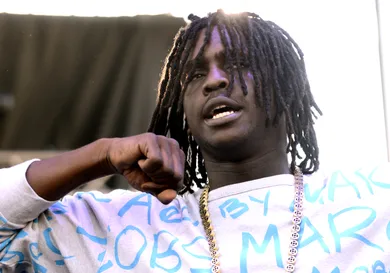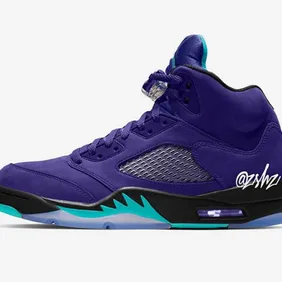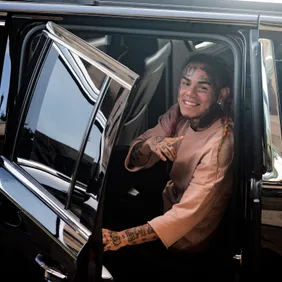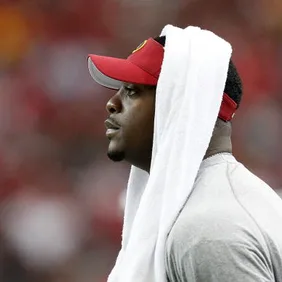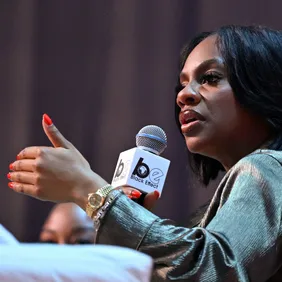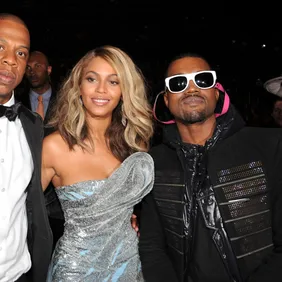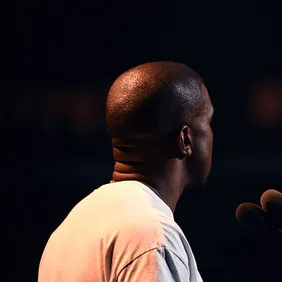“Chief Keef is just another product from a world and a society that is violent and promotes violence. Every image that comes in front, particularly of young people, is violent. Not to mention the violence that oft-times is found in the home. All of these things play a role in the shaping of a Chief Keef or others. Because at the root of it, you’ll find these are very beautiful people.”
- Ishmael Muhammad, Student Minister, Nation Of Islam
It’s late afternoon in a suburb on the North Side of Chicago in 2014. The house in question is the kind of dream home one might expect to see in the latest Sotheby’s Realty luxury listing. Outside, members of Glory Boyz Entertainment strut around, shrouded in thick clouds of weed smoke and dust being generated by Chief Keef, a.k.a. Keith Cozart, whipping around on an ATV. What was once a pristine lawn has become a rugged race track. The noise is deafening. Onlookers pass in silence, stunned by the audacity of their neighbors. The bizarre scene offers the most explicit of juxtapositions. It’s as if 64th and Normal has been plopped down in the middle of quaint white suburbia. Keef, however, remains unfazed by his surroundings. And while the Noisey crew is eagerly waiting for Almighty Sosa to dismount and offer but a few words for their YouTube series, the Chicago artist wants nothing to do with them: “Fuck them cameras. Nah, I’m done, man. Fuck everybody!”
Insular and abrasive, with little regard for consequences, Keef has never felt the need to take responsibility for his actions or the violence that his music champions. He’s doggedly unapologetic, beholden to no one. Contrary to popular belief, he’s not simply the product of media hype, nor is he a dime a dozen artist that can be neatly pigeonholed. For someone as highly visible as Keef, a savvy social media provocateur, his career arc has been surreal to watch unfold. At only 22-years-old, Keef finds himself in the unique position of still coming into his own as an artist, while also serving as an arbiter of the times and a crowned, if complicated, lord of the genre. While many artists have turned away from Keef, treating him as a scapegoat, others have noted, even praised, his power as an influencer and trendsetter. His work not only highlights the cruel underbelly of Chicago’s gangland activity, but also flashes a middle finger to the rest of the world.
While his career has been tarnished by brushes with the law, Keef has remained steadfast in his approach, even after certain media outlets have tried to peg him as insufferable and incoherent. In interviews, he comes off as dismissive, displaying the dead-eyed intensity of someone with more important matters to deal with. Yet Keef’s authenticity remains a central component of his appeal as one of hip hop’s most polarizing acts. His cult-like fan base continues to ravenously consume anything that he puts out, even five plus years after his debut album, Finally Rich, landed on the charts to the tune of 50,000 first weeks sales.
That number is in no way indicative of his actual impact within hip hop. Nor does it capture his ubiquity at the height of his career. And while the songs continue to come in droves, it’s strange to consider that Keef has practically disappeared from mainstream hip-hop. His two biggest hits to date, “I Don’t Like” and “Love Sosa,” were only certified platinum last year and will likely be his sole plaques. It seems almost inconceivable that someone so young and with so much talent could already be past their prime. Even more puzzling is Keef’s current place in hip hop, now that his 24-7 blogosphere coverage has ground to a halt.
For better or worse, the initial proliferation of coverage embedded him in the national consciousness. In the face of it all, Keef remained unflappable. By the age of 17, he had established his image, sound, and persona in manners unparalleled. The shirtless, turnt up antics of the anthemic “I Don’t Like,” shot while the Chicago rapper was on house arrest at his grandmother’s home, served as Keef’s dissertation on Chicago gang life. He personified what he said; his conviction to not give up on the lifestyle, even after it inevitably turned violent, was downright terrifying for many listeners. To the chagrin of conformists, who viewed him as a sign of the apocalypse, Keef wasn’t interested in the narratives surrounding him or his hometown. One of rap’s elder statesman, Lupe Fiasco, expressed some grievous concerns: “Chief Keef scares me. Not him specifically, but the culture that he represents. The murder rate in Chicago is skyrocketing… The incubator’s working overtime. It’s sending these kids to slaughter.”
Nonetheless, Chicago’s youth related to Keef’s portrayals. One need look no further than the viral video of a young fan’s impassioned response to Keef’s naysayers to understand why the young generation gravitated toward his message. His music stemmed from a world that most would rather pretend didn’t exist beyond the realm of entertainment; autobiographical realness that has been largely whitewashed from the mainstream. His unvarnished truths, presented in threats and joyless street platitudes, have had an undeniable impact on hip hop in its current popular incarnation. Now, Keef has established a more carefree existence in California, far from the terrors of his youth. Yet his life transition hasn’t been met with the same massive coverage of years past, when the media clambered to hijack the conversation surrounding Keef’s bedroom full of guns. The critics haven’t gone away; it’s simply that they only care when things take a turn for the worse.
The establishment is only now beginning to open up to the idea of Keef being one of the most influential hip hop artists of his time. His music speaks directly to his fan base while at the same time posing a challenge to the uninitiated. To describe Keef’s music as “nihilistic” seems myopic, yet the word has come to represent everything about his image. It has undermined his perceived longevity as an artist, and contributed to his evolution as a cult celebrity and meme. Of course, Keef hasn’t made it easy on himself, constantly finding ways to land in hot water and far from the good graces of the industry’s gatekeepers. "I feel like I need to separate myself from hip hop, don’t let nobody come around me, don’t let nobody learn from me," Keef menacingly states on the titular skit of Nobody 2.
Chief Keef is an anomaly and unlikely visionary. His music offers glaring warning signs that are strikingly more visible than the socially conscious teachings of fellow Chicago artists such as Lupe Fiasco, Chance The Rapper, and Common. Though Keef’s sound has certainly experienced its fair share of changes, it has retained the core elements of his personality without being tempered by the money-grubbing tendencies of label executives. True, he has been criticized by law enforcement, politicians, and members of the hip hop community who balk at his unorthodox tactics. Yet in his rise as a street legend, Keef made the violence visible through his music. He captivated listeners, many of whom saw his life as a version of their own. His emergence from the depths of obscurity reaffirmed rap as a means of escape, a triumph that resonated with youth whose families had been broken over drugs and gang wars. Having since reached a global audience through YouTube and a robust social media presence, he continues to document his life with unbridled honesty and, more recently, a refined sense of purpose.
